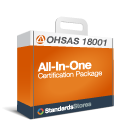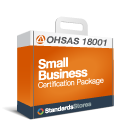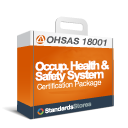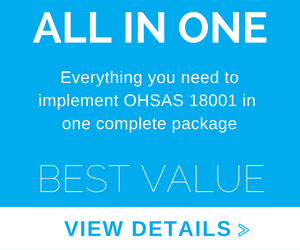How do we Manage Risks with OHSAS 18001?
If you have decided to implement an OHSMS in your company then you know that you will need to have systems in place in order to meet the requirements of OHSAS 18001. A key health and safety requirement outlined in clause 4.3.1 of OHSAS 18001 deals with “Hazard identification, risk assessment and determining controls”.
As you begin your OH&S program, there are four important project activities to consider:
1. Gap Analysis
An early step in meeting this requirement is to perform a gap analysis. The gap analysis sets the stage for the steps that will lead to a complete risk analysis and risk management of health and safety for your organization. It is one of the most important steps in your project because it outlines what areas of your current system need improvement to meet OHSAS 18001.
2. Initial Review
The Initial OH&S reviews are logical next steps. The reviews are used to identify the workplace areas that are under control and highlight the one where hazards are identified and need attention. Initial reviews are considered a pre-requisite to the analysis and the management of risks associated with the identified hazards. The Initial OH&S Review is not considered an audit. The OH&S review is an initial assessment to help create an OHSMS while the OH&S audit assesses the performance of the OHSMS.
3. Risk analysis
The information collected with the gap analysis and the initial reviews is used within the constraints of the business operating parameters, to manage the risks with the systematic assessment and analysis of risks. Health and safety risks can vary and be very different depending on the nature of the business and / or products.
4. OH&S Performance
With the determination, implementation and monitoring of controls needed to mitigate the effects of the hazards and their risks; the risk management loop is completed with improvements in health and safety performance. Corrective actions are identified and improvements in OH&S performance result in workplaces that are safer and healthier.
The Risk Analysis Guide:
The Risk Analysis Guide addresses the OHSAS 18001 requirements of clause 4.3.1, Hazard identification, Risk assessment and Determining of controls as a risk management initiative.
As you proceed with your OH&S project, the 42-page guide includes everything you’ll need to complete the assessments of risks and manage the health and safety risks for your organization.
Add To Cart $29.00
Benefits of the Risk Analysis Guide:
With the risk analysis guide you will have the tools / checklists needed to complete the initial OH&S reviews for both your office and plant workplaces. In addition, you will have the risk analysis tools / worksheets to systematically identify hazards, assess the risks associated with them and determine the controls needed to improve your OH&S performance.
How it works
Our risk analysis exercise is intended to provide a practical and simple approach to risk management that can be applied to all types of workplaces where health and safety risks can vary and be very different depending on the nature of the business and products/services in a wide range of industries.
For example, the risk analysis for an administrative setting such as a security guard service can reveal conclusions with simple solutions, while a more complex industrial environment such as with steel making or manufacturing processes can yield conclusions and solutions that could be very technical and complicated. Education in risk management is available through training seminars to address your specific situation.
However, a cost effective approach is to begin the process with our risk analysis guide. The risk analysis exercise starts with the preparation of process flow diagrams to describe the activities/steps. It follows with the initial reviews and the completion of checklists to identify hazards that may be present in your workplaces. It continues with the use of an 8-column risk management worksheet that takes you through a series of information gathering actions designed to assist in deciding whether or not a hazard and/or process step is at risk and concludes with taking appropriate corrective actions.
And the important result of… A safer and healthier workplace!
With the risk analysis guide, you will:
- See how flow diagrams play a role in risk analysis.
- Identify where risks can be introduced at the process steps.
- Describe existing and new risks.
- Assess the significance of described risks.
- Determine if a next step in the process will eliminate or reduce the risks.
- Describe the controls that are in place to eliminate or reduce the risks.
- Decide when a process step is at risk, and
- Take corrective actions.
This Product is an electronic document which you can immediately download upon completing your transaction.
Add To Cart $29.00







